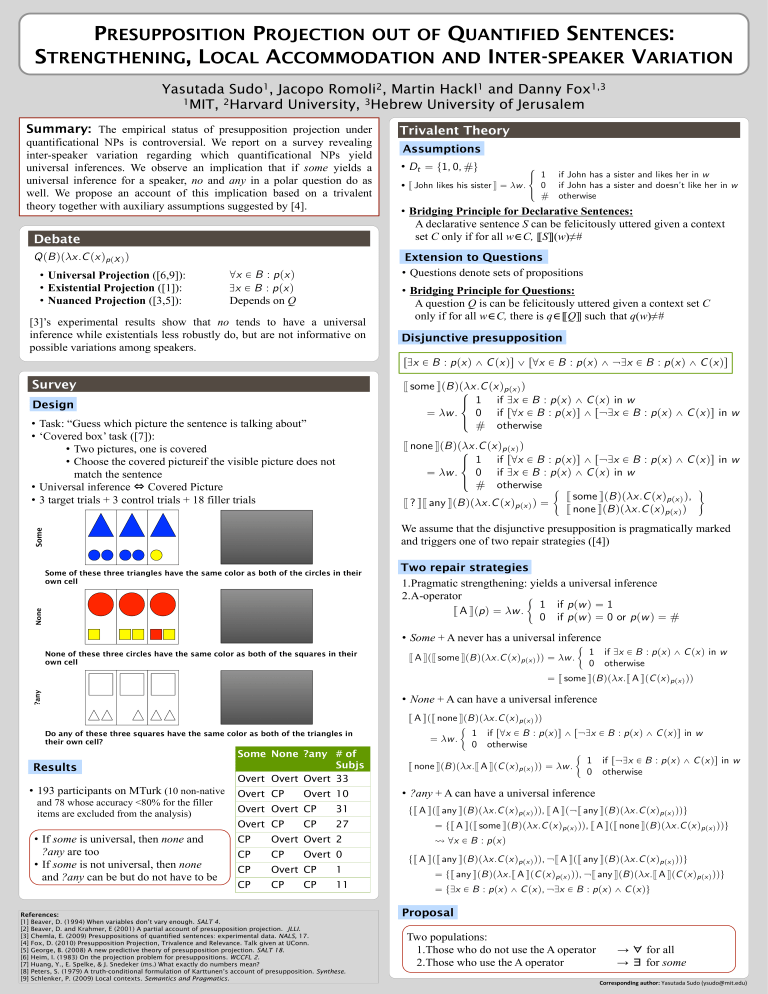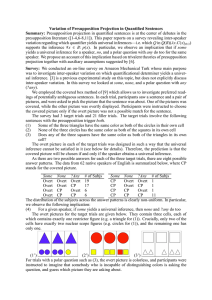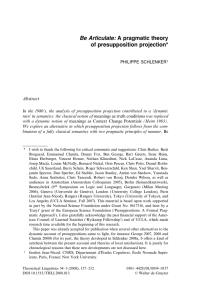P Q S
advertisement

PRESUPPOSITION PROJECTION OUT OF QUANTIFIED SENTENCES: STRENGTHENING, LOCAL ACCOMMODATION AND INTER-SPEAKER VARIATION 1 Sudo , 2 Romoli , Yasutada Jacopo Martin and Danny 1MIT, 2Harvard University, 3Hebrew University of Jerusalem Summary: The empirical status of presupposition projection under quantificational NPs is controversial. We report on a survey revealing inter-speaker variation regarding which quantificational NPs yield universal inferences. We observe an implication that if some yields a universal inference for a speaker, no and any in a polar question do as well. We propose an account of this implication based on a trivalent theory together with auxiliary assumptions suggested by [4]. Debate QpBqp x.C pxqppX q q • Universal Projection ([6,9]): • Existential Projection ([1]): • Nuanced Projection ([3,5]): 1 Hackl 1,3 Fox Trivalent Theory Assumptions •D t “ t1, 0, #u • $ & 1 0 v John likes his sister w “ w . % # if John has a sister and likes her in w if John has a sister and doesn’t like her in w otherwise • Bridging Principle for Declarative Sentences: A declarative sentence S can be felicitously uttered given a context set C only if for all w∈C, [[S]](w)≠# Extension to Questions • Questions denote sets of propositions @x P B : ppxq Dx P B : ppxq Depends on Q [3]’s experimental results show that no tends to have a universal inference while existentials less robustly do, but are not informative on possible variations among speakers. • Bridging Principle for Questions: A question Q is can be felicitously uttered given a context set C only if for all w∈C, there is q∈[[Q]] such that q(w)≠# Disjunctive presupposition rDx P B : ppxq ^ C pxqs _ r@x P B : ppxq ^ Dx P B : ppxq ^ C pxqs Survey v some wpBqp$x.C pxqppxq q & 1 if Dx P B : ppxq ^ C pxq in w 0 if r@x P B : ppxqs ^ r Dx P B : ppxq ^ C pxqs in w “ w. % # otherwise Design • Task: “Guess which picture the sentence is talking about” • ‘Covered box’ task ([7]): • Two pictures, one is covered • Choose the covered pictureif the visible picture does not match the sentence • Universal inference ⇔ Covered Picture • 3 target trials + 3 control trials + 18 filler trials v none wpBqp$x.C pxqppxq q & 1 if r@x P B : ppxqs ^ r Dx P B : ppxq ^ C pxqs in w 0 if Dx P B : ppxq ^ C pxq in w “ w. % # otherwise " * v some wpBqp x.C pxqppxq q, v ? wv any wpBqp x.C pxqppxq q “ v none wpBqp x.C pxqppxq q Some We assume that the disjunctive presupposition is pragmatically marked and triggers one of two repair strategies ([4]) None Some of these three triangles have the same color as both of the circles in their own cell Two repair strategies 1.Pragmatic strengthening: yields a universal inference " 2.A-operator 1 if ppw q “ 1 v A wppq “ w . 0 if ppw q “ 0 or ppw q “ # • Some + A never has a universal inference None of these three circles have the same color as both of the squares in their own cell v A wpv some wpBqp x.C pxqppxq qq “ w . " 1 0 if Dx P B : ppxq ^ C pxq in w otherwise ?any “ v some wpBqp x.v A wpC pxqppxq qq • None + A can have a universal inference Do any of these three squares have the same color as both of the triangles in their own cell? Results • 193 participants on MTurk (10 non-native and 78 whose accuracy <80% for the filler items are excluded from the analysis) • If some is universal, then none and ?any are too • If some is not universal, then none and ?any can be but do not have to be Some None ?any # of Subjs Overt Overt Overt 33 Overt CP Overt 10 Overt Overt CP 31 Overt CP 27 CP CP Overt Overt 2 CP CP CP Overt CP 1 CP CP 11 Overt 0 CP References: [1] Beaver, D. (1994) When variables don’t vary enough. SALT 4. [2] Beaver, D. and Krahmer, E (2001) A partial account of presupposition projection. JLLI. [3] Chemla, E. (2009) Presuppositions of quantified sentences: experimental data. NALS, 17. [4] Fox, D. (2010) Presupposition Projection, Trivalence and Relevance. Talk given at UConn. [5] George, B. (2008) A new predictive theory of presupposition projection. SALT 18. [6] Heim, I. (1983) On the projection problem for presuppositions. WCCFL 2. [7] Huang, Y., E. Spelke, & J. Snedeker (ms.) What exactly do numbers mean? [8] Peters, S. (1979) A truth-conditional formulation of Karttunen’s account of presupposition. Synthese. [9] Schlenker, P. (2009) Local contexts. Semantics and Pragmatics. v A wpv none wpBqp x.C pxqppxq qq " 1 if r@x P B : ppxqs ^ r Dx P B : ppxq ^ C pxqs in w “ w. 0 otherwise " 1 if r Dx P B : ppxq ^ C pxqs in w v none wpBqp x.v A wpC pxqppxq qq “ w . 0 otherwise • ?any + A can have a universal inference tv A wpv any wpBqp x.C pxqppxq qq, v A wp v any wpBqp x.C pxqppxq qqu “ tv A wpv some wpBqp x.C pxqppxq qq, v A wpv none wpBqp x.C pxqppxq qqu @x P B : ppxq tv A wpv any wpBqp x.C pxqppxq qq, v A wpv any wpBqp x.C pxqppxq qqu “ tv any wpBqp x.v A wpC pxqppxq qq, v any wpBqp x.v A wpC pxqppxq qqu “ tDx P B : ppxq ^ C pxq, Dx P B : ppxq ^ C pxqu Proposal Two populations: 1.Those who do not use the A operator 2.Those who use the A operator → ∀ for all → ∃ for some Corresponding author: Yasutada Sudo (ysudo@mit.edu)


